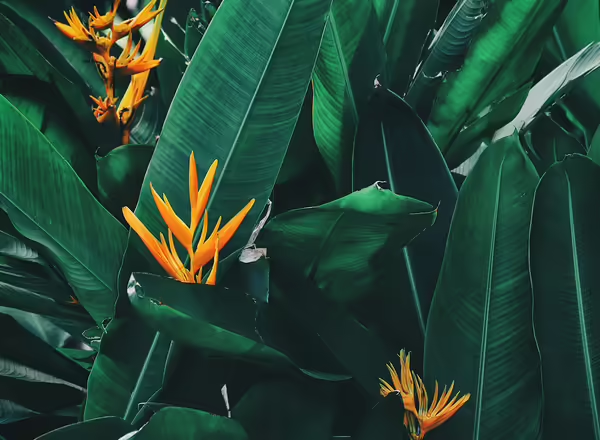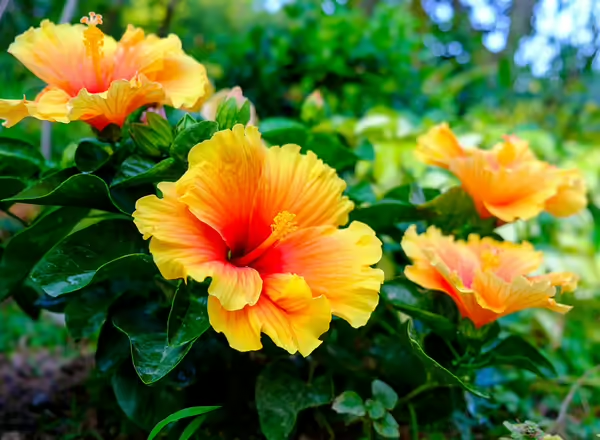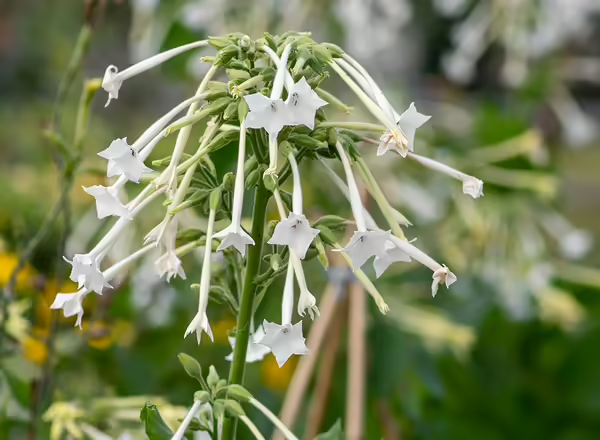
Tropical Plants
Change the look of a traditional annual or perennial border by skillfully placing just a few tropical plants in the right place for impact. You'll be captured by the huge, shiny leaves, bold outrageous colors, and ferny textures.
Using tropicals in the outdoor garden is nothing new. Plant collectors have grown and collected them for hundreds of years. Annuals such as geraniums, impatiens and begonias are actually tropicals. During Victorian times, tropicals were all the rage. Lavish outdoor displays were created during the summer and then these plants were moved into “glass houses” to be overwintered for use in next season’s garden. This style of gardening was novel and new at the time. It is seeing a revival, because it tends to draw attention to the garden.
And if it’s attention you want, just incorporate a few tropical plants into a flower border and wait for the second looks, stares, and smiles from visitors to the garden. They will wonder if they are in the Midwest or many miles south.

It’s easy to create a unique display of tropical foliage even if you are gardening in the Midwest. In most cases, we enjoy summers that get plenty of sun, heat and humidity along with occasional heavy rains. These conditions fuel the growth of tropicals into high gear so that even if you start out with small specimens, they grow unbelievably fast and turn into large, imposing plants in a matter of weeks. In July and August when temperatures and humidity are at their highest, traditional garden plants often struggle to look good, but tropicals are in their element and look outstanding.
A border planted with tropicals gets better as the season progresses. Many popular houseplants such as rubber plant, dieffenbachia, spider plant, spathiphyllum, pothos, and croton, when rescued from dark corners of your home, make excellent additions to the tropical border. You can grow tropicals directly in the ground or in containers.
Plants in containers can be placed by entrances, patios and decks or plunged into the ground in annual or perennial borders. This makes it easier to move them inside for the winter.

Many perennials can give the garden a tropical feel. Choose from Arunucus (goatsbeard), Flipendula (meadowsweet), large ornamental grasses such as Erianthus (hardy pampas), Rheum (ornamental rhubarb), Crambe, and many hardy, large-leaved ferns. Hardy hibiscus (Hibiscus moscheutos) with their large flowers (8-10 inches across) can bring the feel of the islands to a midwestern garden. Some of the large-leaved hosta cultivars such as ‘Sum and Substance’, ‘Blue Mammoth’ and ‘Sun Power’ can add a tropical look. Other winners in the big foliage category include Butterbur (Petasites giganteus) with huge 2-3 foot leaves and ornamental rhubarb (Rheum sp.) that grows to an imposing specimen with two-three foot wide leaves.

One of the most basic, diverse and dramatic garden plants is the canna. Cannas are easy to grow, offer a vast array of foliage and flower colors and range in height from 18 inches to over six feet. They are easy to overwinter and can be used just about anywhere a tropical accent might be needed. They prefer full sun for best performance and can tolerate moist to wet areas such as around water features.

Many seed grown annuals can easily be used to portray a tropical look. Castor beans grow into huge imposing plants, 6-8 feet tall with large colorful leaves and interesting flowers and seedpods. Nicotiana sylvestris (candleabra tobacco) has large green leaves reminiscent of large tobacco plants along with white fragrant flowers that give the look and feel of the tropics.
Tropicals fit almost every situation in the garden ranging from full sun to shade. Whether tropicals are grown in the ground or in containers, attention will need to be given to moisture and fertility. Most tropicals prefer soils that are uniformly moist so water thoroughly. Allowing them to dry out affects foliage quality. They are heavy feeders meaning they should be fertilized once every week or two with a liquid fertilizer. Fertilizers high in nitrogen will help keep the plant actively growing and producing large, healthy leaves.
Overwintering
Most tropicals are perennials in their native habitat. When used in midwestern landscapes, they are basically “one timers.” They die quickly if exposed to freezing temperatures. Overwintering allows you to start out with fairly large specimens for immediate impact. Having these plants on hand can be a time and cost saver. Instead of buying new each year, consider overwintering valuable specimens. The measures you take depend on the particular plant and its value as well as the facilities you have to successfully overwinter them.
There are five basic choices when it comes to overwintering tropicals:
-
Overwinter the plant as a growing houseplant if you have proper conditions indoors
- Store it as a dormant plant, tuber or root
- Collect seed
- Take cuttings
- Leave it outside in a protected location providing it with suitable mulch or covering.
When it comes time to reintroduce tropicals to the garden, wait until night temperatures remain in the 50-degree range and the soil has warmed. Cold air and cold soil keep tropicals from growing, but warm soil and air will result in plants that take off and grow unbelievably fast.
As a Growing Houseplant
Many tropicals can be overwintered as houseplants.
- Large specimen palms, bananas and ficus can be brought indoors and enjoyed so long as two requirements are met – high amounts of light and added humidity.
- Provide plants with the brightest location possible.
- Locate plants in high humidity areas if good light is available or group plants together. Grouping naturally raises the humidity in the vicinity. Expect some leaf loss when they are brought indoors from their outdoor location.
Bulbs, Tubers, and Corm
Many tropicals such as elephant ear, canna, and caladium form bulbs, tubers or corms.
- When these plants die back, these underground structures can be dug and stored in a cool, dark place through the winter.
- The best time to dig the bulbs and tubers is after a light frost has killed the tops back.
- Trim the stems down to 4-6 inches and dig the plant up.
- Allow the tubers to dry slightly for a day or so before storing.
- Place the tubers in a crate or box with ventilation holes and bury the tubers in peat moss or wood shavings.
- Place the box in a cool (45-50 degree), dark area.
- Inspect the tubers regularly through the winter checking for rotting or excessive shrinkage.
- If tubers are drying out, add just a small amount of moisture to the peat.
- About 4-6 weeks before the last frost in the spring, pot the dormant tubers and place them in a warm, sunny area. This will give you a head start on having some tropical transplants for your garden.
Bananas
These are some of the easiest tropicals to overwinter. Overwintered bananas can become extremely large and even more exotic the following season.
- If the banana is container grown, cut the plant down to about 4-6 inches just before you bring it indoors.
- Store the container in a cool (45-50 degree), dark area.
- Keep the soil dry.
- In the spring, increase watering and a new shoot will push up from the center of the stem.
- Place outdoors after frost when temperatures start to warm.
- If the banana was grown in the ground, dig it up before frost.
- Leave the soil around the roots and wrap the root ball in a plastic bag.
- Do not cut the plant back. Store the plant in a cool, dark location.
- The stem will dry down naturally.
- In the spring, cut the old stem off and replant after danger of frost is past.